Employee referral programs can deliver big results for companies looking for low-cost and effective ways to grow their businesses.
In today’s digital environment, your audience is much less likely to trust ad messages. They’d rather do the research on their own, which informs their opinions about your company and products before you can reach them.
It’s time to look to your best brand ambassadors – your own employees – to attract new hires and new customers.
Let’s dive into what makes employee referrals so powerful, plus best practices for both types of employee referral programs.
What is an employee referral program?
An employee referral program is a marketing strategy where a businesses encourages employees to recommend best-fit candidates for job vacancies within a company, or recommend products and services to peers, family members, or friends.
In exchange, your employees can earn incentives, or referral rewards, when they bring in a successful hire or a sale.
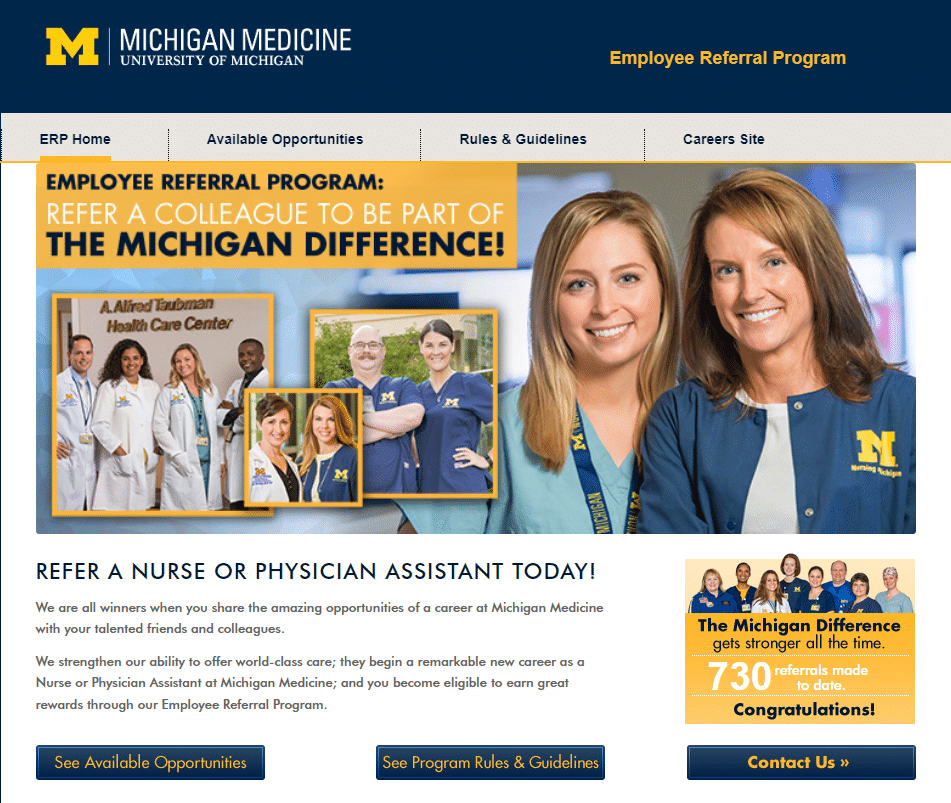
The two types of employee referral programs
Employee referral programs come in two types:
- The first type of employee referral program encourages current employees to help you find job candidates.
- The second rewards employees for recommending your products or services to their peers.
The most common type of employee referral program is one where your employees recommend good-fit candidates to apply for positions at your company. This is known as an employee-to-employee referral program.
But in the other program type, employees recommend your products and services to people they have a relationship with. Here, your employees are acting as brand ambassadors. This is known as an employee-to-customer referral program.
Both types of employee referral programs utilize the knowledge and network of employees to grow your business. Employees know your business inside out, and they are often your most valuable resources to bring in high-quality leads and top talent.
| Employees refer job candidates | Employees refer potential customers | |
| How it works | Employees encourage good-fit potential candidates to apply for positions at your company | Employees act as brand ambassadors and recommend your products to peers |
| Employees share… | Information about the job with their peers | Why they love your brand’s products or services with their peers |
| Employees earn rewards… |
|
When their referred peers make purchases |
While it seems complicated to set up, create, and run programs like these, it doesn’t need to be a difficult process.
You can easily manage both programs using referral program software, which helps track all referral activity.
Why do you need an employee referral program?
As part of the regular recruitment process or lead generation strategies, businesses can spend considerable time, money, and effort on achieving goals. If you’re not using employee referral programs, you are missing out on a goldmine of the best talent and leads.
Your employees personally know your brand and company culture. They’re uniquely positioned to refer higher-quality candidates, new customers, or both.
If you’re looking for employees, implementing an employee referral program can boost your recruitment strategy, widen your talent pool, provide a strong impresssion of your employer brand, and streamline the hiring process.
- Employee referrals have a proven track record for bringing in new hires – they brought in 30% of all hires and 45% of internal hires in 2016.
- Having employees directly recommend candidates results in a shorter time-to-hire than putting out job posts. Referred applicants are able to start as early as 29 days after being referred, as opposed to 39 days for applicants hired through job boards, and 55 days for applicants hired through career sites.
- Employees who are referred are more likely to stick with your business, a factor that can be measured using employee retention rates. Retention rates of referred employees are very high at the end of the first year, at 43%, as opposed to 33% for traditional recruitment on career sites. To put it another way, the turnover rates of referred employees are much lower. This can also lead to a lower cost-per-hire, and lower recruiting costs overall.
- Referrals are also the best source of high-quality hires, giving them a greater potential to produce more revenue. Referred workers are roughly 25% more profitable than non-referred workers. It helps that they often have a built-in mentor to help them through the onboarding process and beyond.
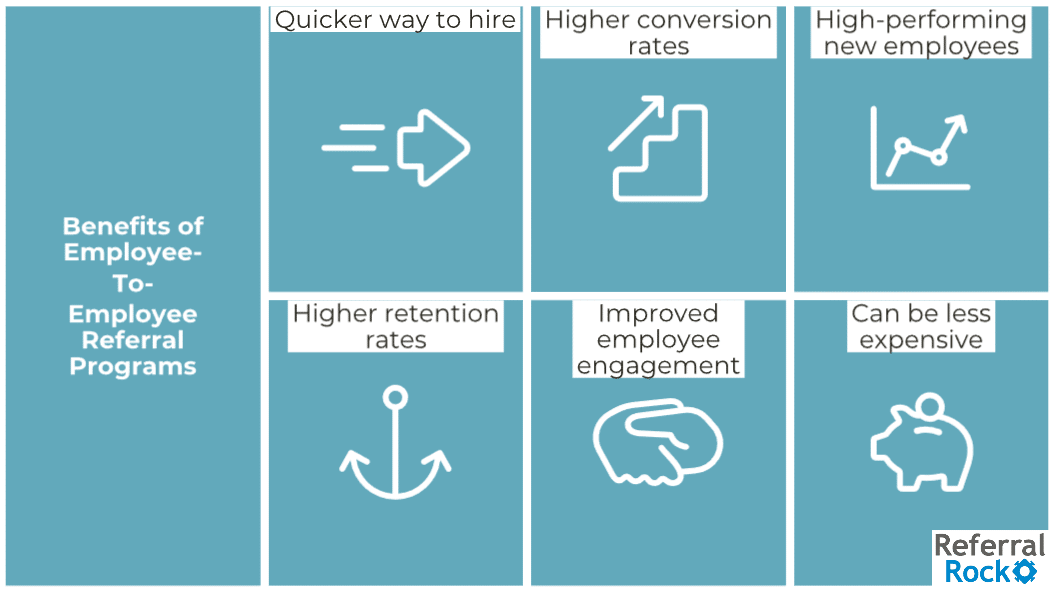
If you’re looking for new customers, your existing employees can be some of your best brand advocates as well. They’re able to explain the value of your products and your brand’s mission in a language their peers will easily understand.
- Referred customers (in any referral program) are more likely to purchase from you. As many as 92% of consumers trust recommendations from friends and family, above all other forms of advertising – even when those peers are your employees.
- Referral programs bring in high-quality customers who are more likely to stay loyal to your brand. The average value of a referred customer is at least 16% higher than that of a non-referred customer in a similar demographic.
- A referral program shows appreciation and rewards for employees. As many as 92% of employees are more likely to repeat the referral process if they’ve been recognized for their actions.
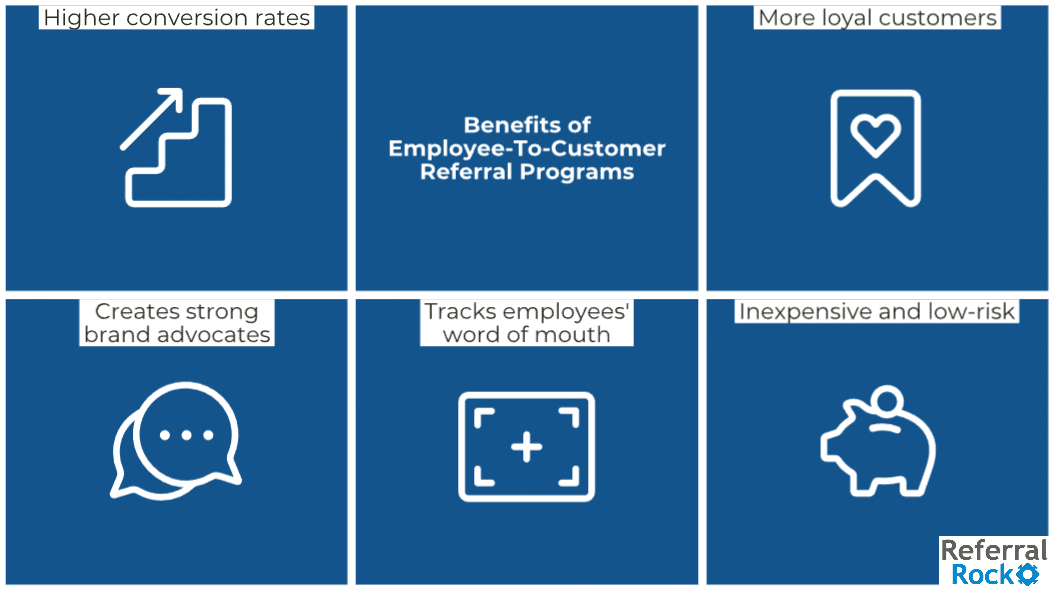
Before you start an employee referral program
Make sure you have the following prerequisites in place to ensure a successful employee referral program:
1. You have highly satisfied and engaged employees. Engaged employees are motivated to perform their jobs well, and aren’t just going through the motions. You can use employee satisfaction surveys to gauge how satisfied your employees are.
2. Your employees know your brand and company culture well. Educational resources and informational updates can help employees internalize your company values, mission, and goals.
3. You know what types of incentives would best motivate employees to refer others. You can even survey your employees for their preferred benefits, similar to how you would carry out an employee satisfaction survey.
Do you want employees to refer candidates? If so, you’ll also need:
- A fairly large company for an employee referral program to be worth your while.
- To familiarize all your employees with what you’re looking for in an ideal employee.
Do you want employees to refer new customers? If so, make sure your employees:
- Know your products or services well.
- Know who your ideal customer is – the type of customer who would be the best fit to use your products or services.
- Provide standout customer service and can handle an influx of new customers.
Employee referral program best practices (for both types of programs)
Follow these best practices to build a strong foundation for either employee referral program type:
1. Use employee referral program software
Employee referral software lets you track exactly where every employee referral came from, and instantly reward your employees for successful referrals.
The best referral software will automate all aspects of setting up and running a program, including tracking key metrics, rewarding employees, and even promoting your program. You should also be able to customize the program to your needs, and integrate with your existing processes.
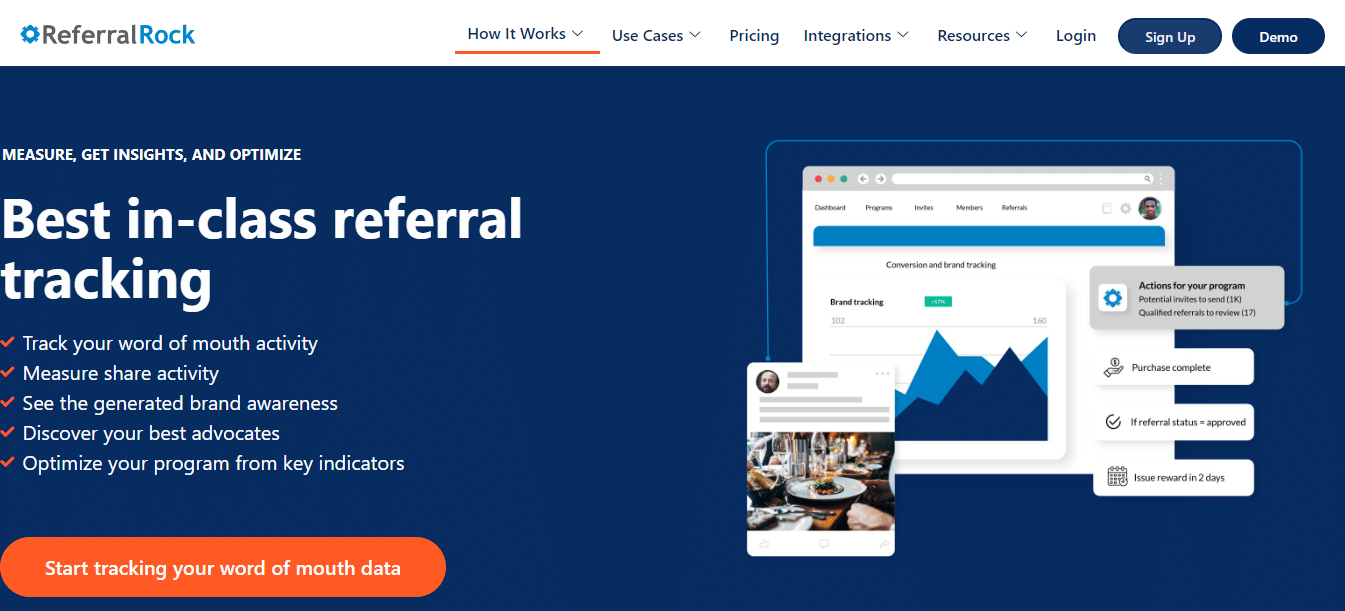
2. Choose rewards that motivate employees
Rewarding employees for referrals shows you appreciate their efforts. Recognition increases employee engagement, improves confidence, and makes employees more productive and willing to go the extra mile.
When you develop your program, offer employee referral bonuses that employees genuinely want to earn:
- Cash payouts work especially well. Pay the cash bonus together with the employee’s paycheck. Alternatively, for an added incentive, make the payouts immediately.
- Gift cards are another incentive that employees appreciate. Try offering gift cards for popular brands like Amazon and Starbucks, or any brands you know employees love.
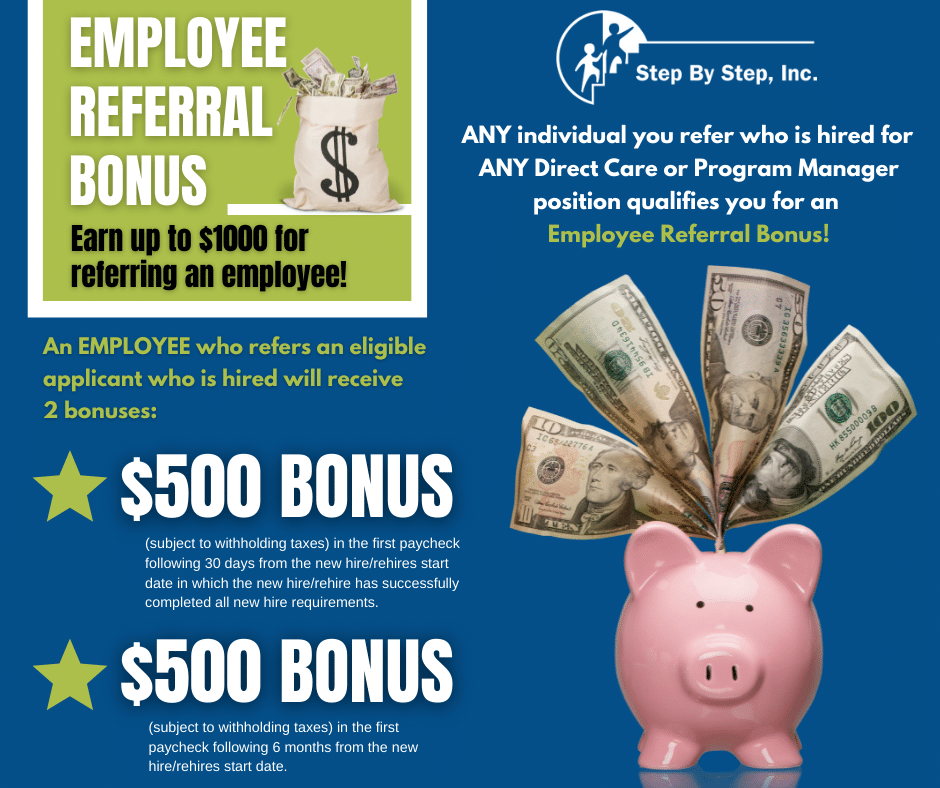
Or, try offering these other well-loved rewards:
- Tickets to major events like sporting events, concerts, or book festivals
- Credit towards travel, or further development/mentorship opportunities, for big referrals
- Extra paid time off
- Gym or spa memberships
- Other tangible incentives, like watches, apparel, phones, tablets, or food baskets
Or, use a drawing structure in addition to your regular employee referral program rewards. In this structure, each successful referral earns an entry into a random drawing for a larger reward, on top of the rewards someone has already earned for the referral.
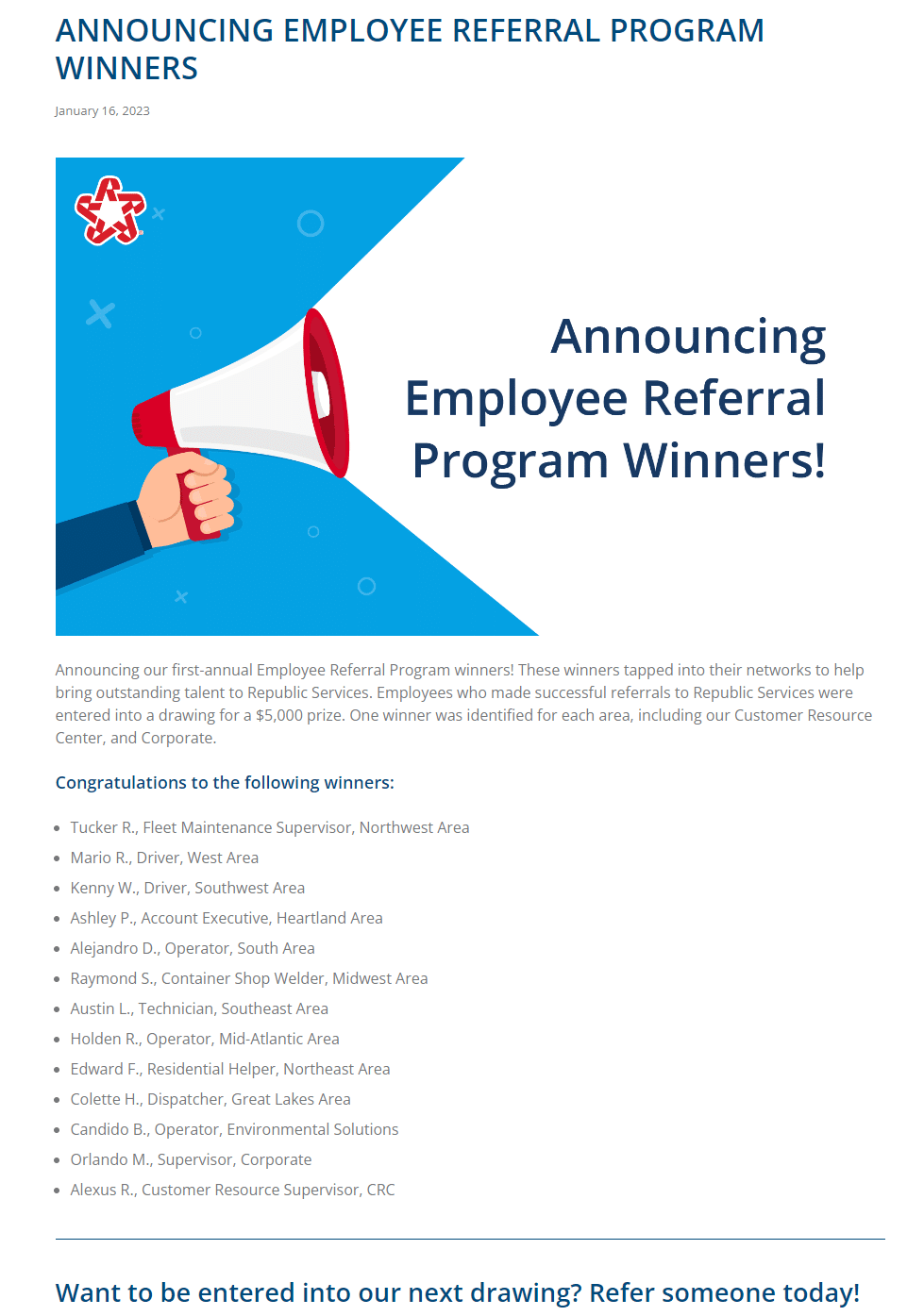
3. Make sharing easy
One of the biggest turn-offs for potential referrers is a referral process that’s too drawn-out or too complicated.
If it’s going to take time to figure out, or requires switching between digital and manual methods, you’re not going to get many referrals.
Make the referral process as easy as possible by reducing the amount of labor and effort involved:
Minimize the number of clicks or taps needed to refer. Keep it simple. Keep it clean. Make it user-friendly.
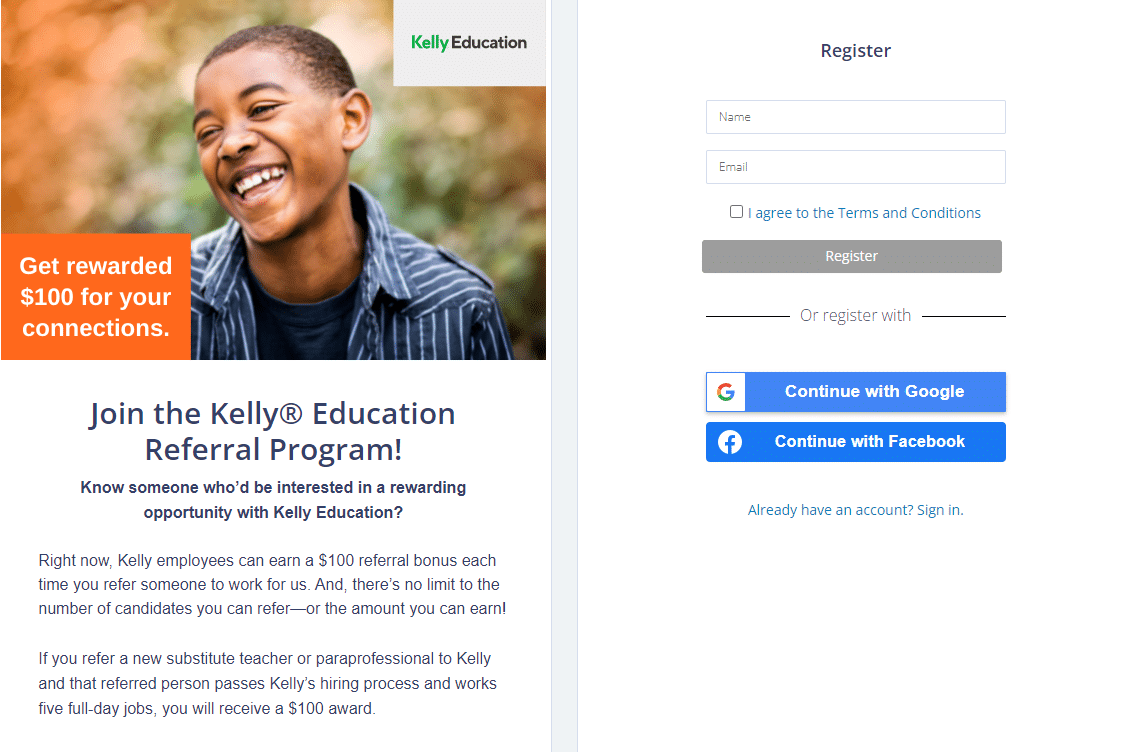
Also, minimize the number of form fields employees must fill in to make a referral. Employee-to-customer referral programs usually only need the employee’s name, email, and basic contact information for the lead.
Employee candidate referral programs may require a little bit more in terms of information, such as an employee ID, contact information for the candidate, the position the candidate is being recommended for, and so on.
Still, keep the number of fields to a minimum. Have the employee give basic information about the referral, and then let the candidate fill in the gaps during the application process.
4. Utilize referral links
Referral links make it easy for your employees to share. It just takes a single click to send a referral link. As a result, referral links can be a powerful tool to generate sales, especially when the employee has a large network of peers they have strong relationships with.
To make things simple for your employees, referral software creates custom referral links and enables both you and your employees to track all referrals that come in.
Employees can easily copy and share these links wherever they talk with peers. They should also have the option to share through email and social media, where the link is automatically included in the message or post.
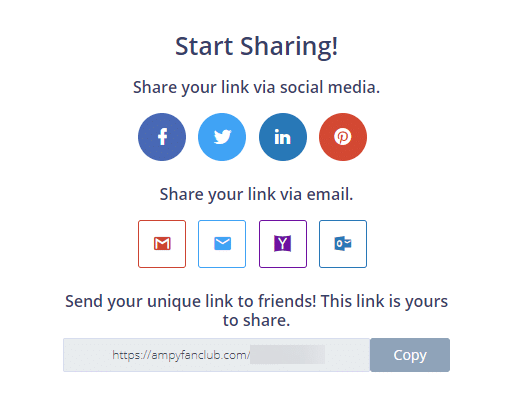
5. Promote your referral program
No matter the type of employee referral program you start, employees need to know about it to make it a success. Promote your referral program using all the channels you typically use to communicate with employees:
- Internal communication portals: Promote the employee referral program in your Slack groups, employee-only forums, employee portals, or any other form of team management software.
- Email communications: Regularly send out program explainers within employee emails. Include the referral link, ideally alongside easy-to-share email and social media buttons.
- Direct conversations: Bring up the employee referral program in one-on-one chats. Share where employees can get more information, and emphasize the ease of the process. Motivate your team members to visit the site and learn about the program.
- Hybrid flyers: Post referral program flyers in the workplace, but directly connect with the digital element of the program by including a QR code (as Jenks Public Schools does below).
- Spontaneous marketing: Take a cue from Booking.com’s employee referral example. To overcome the challenge of finding Portuguese-speaking representatives, they bought Portuguese lunch for the entire office and left referral cards! A happy hour can also be a great place to promote your referral program.
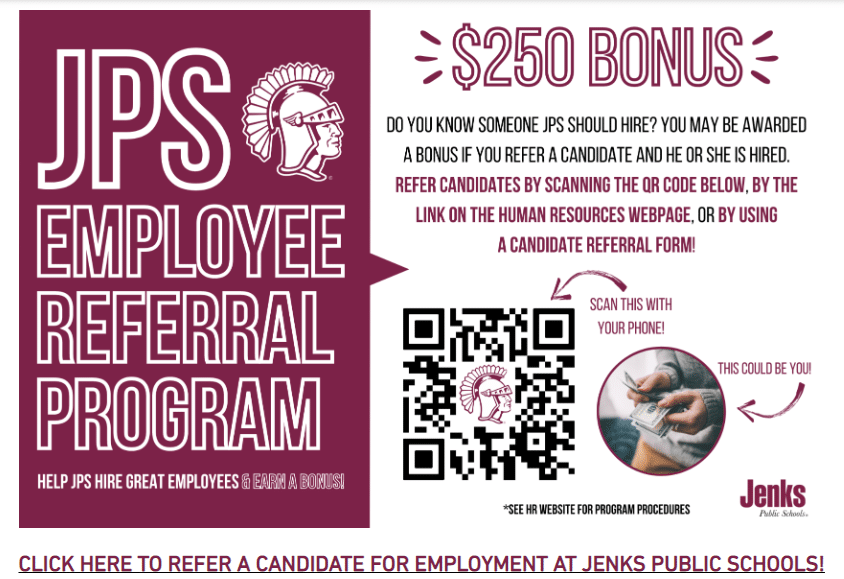
Pro tip: Shout out employees who have made the most successful referrals in Slack, company emails, or even during an all-hands meeting. This both promotes your program to employees who haven’t referred before, and further motivates top sharers to keep referring candidates or leads.
Employees can be highly motivated by knowing their efforts aren’t getting lost down a large black referral hole. Plus, it’s gratifying to be recognized in front of your peers.
6. Leverage the employee’s personal connections
No matter how far we’ve come digitally, personalization still rules when creating a bigger impact. Imagine getting a personalized message from a friend who works at a given company, instead of just getting a generic email from that company!
Give employees an option to write a personalized message for the candidate or lead they’re referring.
You can also offer suggestions within the referral form for what the employees can write in their messages. This makes things easier, so employees aren’t struggling to compose a message that’s both friendly and professional.
Best practices when employees refer job candidates
There are some more best practices to make use of when running employee referral programs for talent acquisition:
Make referral terms clear
Make sure the rules of your program are clear and simple. Here are some of the most common questions to address in your employee referral program policy:
- What are the eligibility rules? In other words, who can participate in the program? (Usually, hiring managers, members of hiring teams, human resources employees, and managers the open position would directly report to, aren’t eligible for rewards.)
- Who should employees refer? Cover what makes an ideal employee, and share details of who wouldn’t make the cut.
- What are the job descriptions for open roles, in clear detail? Someone in a different department of the company will probably need more information about requirements for a specific job opening. Run each job description by a few employees outside the department before making it live.
- When will an employee become eligible for the referral reward?
- What happens if a candidate gets referred by multiple employees? Does the first referrer or most recent referrer get the reward?
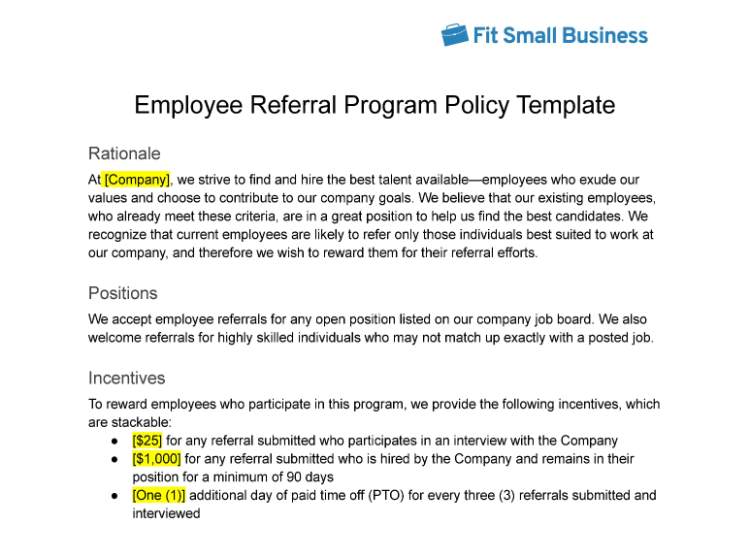
Offer tiered or stepped rewards
Stepped employee referral rewards recognize employees at different stages of the candidate referral process. Here’s a sample stepped reward structure you can adopt for your employee referral program:
- Offer the first and smallest reward (say, a $5-$10 gift card) when the candidate applies for the job.
- Offer a larger reward (say, a smaller cash payout or larger gift card) if the candidate is accepted for an interview.
- Offer the largest reward (say, a large cash payout, high-value reward, or even a free trip) when a referred candidate gets hired.
You could also start a tiered employee referral program, which awards higher bonuses the more qualified referrals employees bring in, or gives extra bonuses the longer a referred employee stays with your business (say, $100 after a referred employee remains at their new job for 30 days, and $500 after that referred employee stays for 90 days). But a program with at least one reward given before the hire tends to be most motivating.
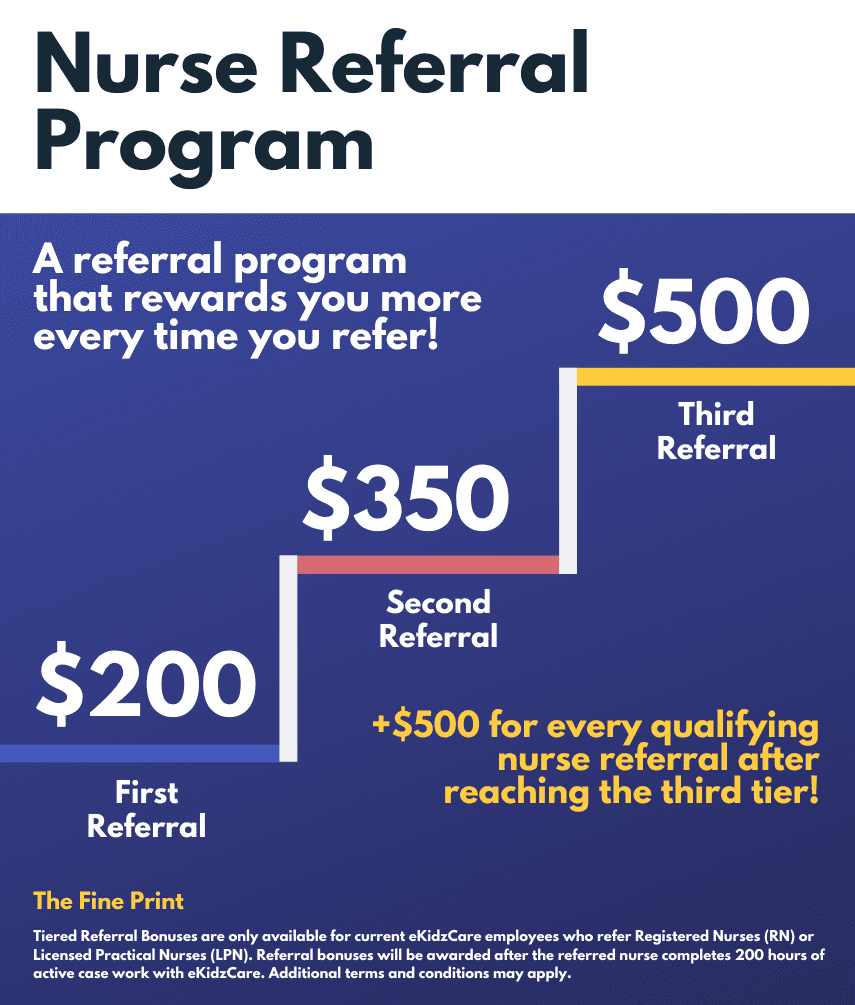
Keep employees in the loop about referrals
Employees want to know if candidates they referred ended up applying, getting interviews, or even accepting a job offer.
Lack of communication about the candidate experience can be extremely demotivating, possibly leading employees to think twice before referring again. They’re invested in the process, so keep them informed.
This is yet another area where employee referral software can help. An employee can easily log into their account and see the progress of all the job applicants they referred. Being transparent with employees about referral progress makes them more likely to refer in the future.
Work to avoid referral bias
Despite your best efforts, referral bias can inadvertently set in. While referral programs are effective, you still need to make sure employee referrals don’t unintentionally end up ruling out job seekers of different races, genders, nationalities, abilities, and perspectives.
- When asking employees for referrals, emphasize that ideal referrals are based on skills, perspectives, and values. Talk about how you want employees with certain skills and values, because this makes the company stronger.
- Regularly evaluate your employee referral program based on the diversity of referrals and hires it brings in. Do an annual audit to see where you need to make changes to further refine the program.
- When providing feedback to employees on the quality of referrals, don’t forget to highlight bias avoidance.
- Fast-track referred candidates through the hiring process, but evaluate all candidates who apply (referred and non-referred) based on the same standards.
Best practices when employees refer customers
In theory, many of the practices that work for referring candidates can work just as well for referring customers. But there are a few marked differences in the way you approach employee referrals for customers:
Reward the new customer as well as the employee
While you’re rewarding your employees, it’s a good idea to reward new customers too. This “double-sided” reward technique makes new customers more likely to purchase from you.
Always tie the new customer’s reward back to your business, whether it’s credits towards your products/services, discounts, free products, or similar rewards. This gives customers an incentive to purchase from, and stay loyal to, your brand.
Consider brand ambassador best practices as you set up your program
Using employees to refer customers is similar to what brand ambassador programs already do.
Brand ambassador programs are campaigns where notable experts function as long-term representatives for a brand. As they advocate for the brand, they increase its relevance and visibility in the market while driving more bottom-line sales.
Since this type of employee referral program is similar to brand ambassador programs, applying brand ambassador program best practices can be beneficial.
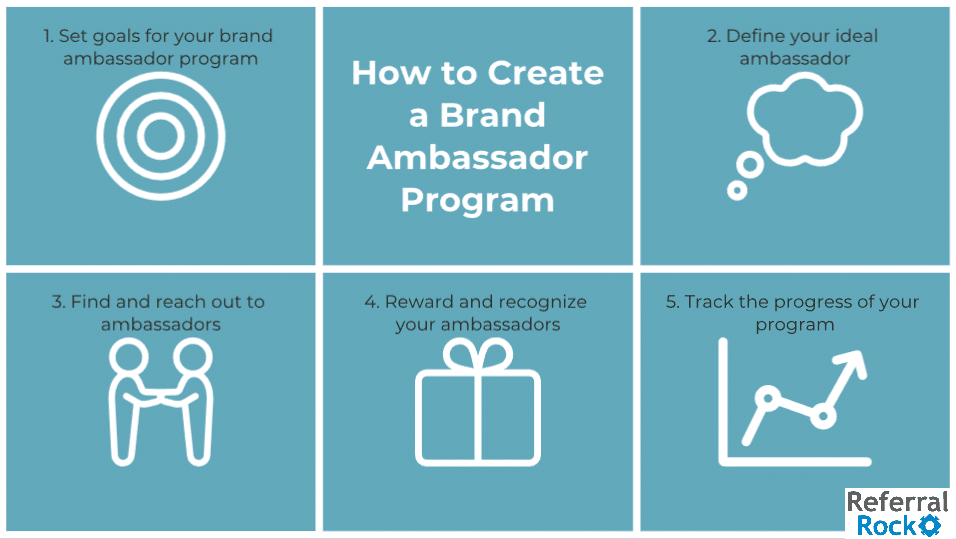
Set and track revenue-related goals
After setting up your program, decide how to measure the results. It’s essential to know how much revenue your employee referral program brings in and whether it’s meeting your expectations.
Define, set, and track goals. Then, use your progress to inform any changes you make to your program.
- Start with tracking your conversion rate, which is the percentage of referred leads who become customers.
- Track the percentages of employees making referrals.
- Identify the revenue generated via referrals within specific time intervals.
- Look at the average purchase value of referred customers vs. all customers.
- Once you’ve been running the program for a while, you can also examine the lifetime value of referred customers vs. all customers.
Consider launching a customer-to-customer referral program as well
A customer-to-customer referral program invites other customers (instead of employees) to refer their friends for rewards.
This strategy can increase your potential to grow your company as it maximizes your word-of-mouth channels and could potentially result in viral sharing.
You can easily run both employee-to-customer and customer-to-customer referral programs using the same type of referral software. And if you’re planning on giving out similar rewards (say, cash or experiential rewards), you might even run the same “friends and family” program for both clients and employees, as Sunrise Senior Living does here.
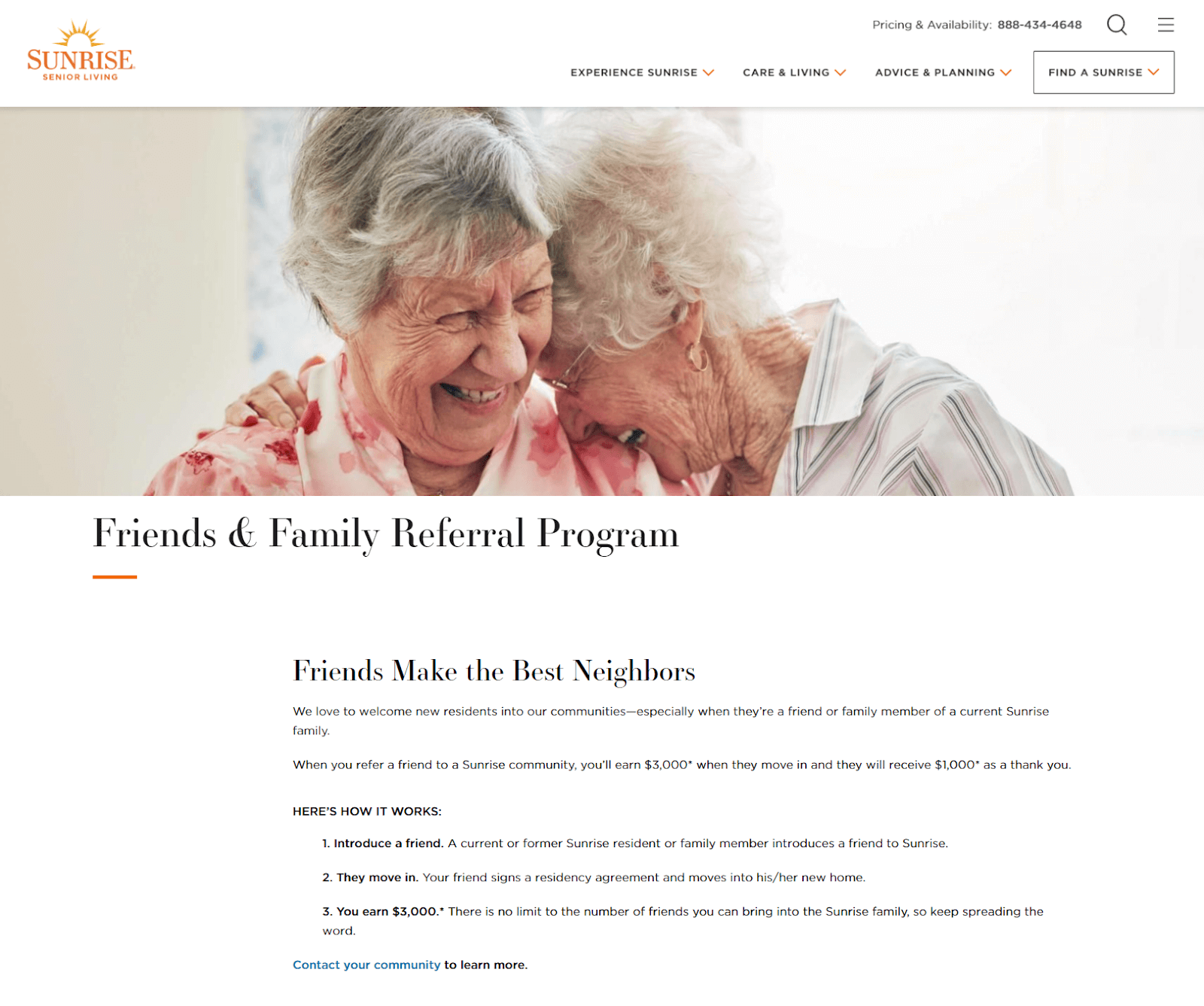
Conclusion
Employee referral programs that bring in new employees as well as new customers can work remarkably well when done right. Follow our best practices and guidelines to set your programs up for success from the get-go.
Remember to continuously improve your programs based on the data you collect with referral software.




